Determination of Initial-Shear-Stress Impact on Ramsar-Sand Liquefaction Susceptibility through Monotonic Triaxial Testing
Abstract
1. Introduction
2. Materials and Methods
2.1. Geographical and Geological Background
2.2. Physical Parameters of Ramsar Sand
2.3. Test Procedure
3. Results and Discussion
3.1. Effect of Confining Pressure on Sand Behavior
3.2. Initial Shear Stress Ratio (α)
3.3. Pore Water Pressure Ratio (ru)
3.4. Pore Water Pressure Ratio Versus the Initial Shear Stress Ratio
4. Conclusions
Author Contributions
Funding
Acknowledgments
Conflicts of Interest
References
- Marcuson, W.F. Definition of Terms Related to Liquefaction. ASCE J Geotech. Eng. Div. 1978, 104, 1197–1200. [Google Scholar]
- Youd, T.L.; Idriss, I.M.; Andrus, R.D.; Arango, I.; Castro, G.; Christian, J.T.; Dobry, R.; Finn, W.D.L.; Harder, L.F.; Hynes, M.E.; et al. Liquefaction resistance of soils: Summary report from the 1996 NCEER and 1998 NCEER/NSF workshops on evaluation of liquefaction resistance of soils. J. Geotech. Geoenviron. Eng. 2001. [Google Scholar] [CrossRef]
- Castelli, F.; Cavallaro, A.; Grasso, S.; Lentini, V. Undrained Cyclic Laboratory Behavior of Sandy Soils. Geosciences 2019, 9, 512. [Google Scholar] [CrossRef]
- Lentini, V.; Castelli, F. Liquefaction Resistance of Sandy Soils from Undrained Cyclic Triaxial Tests. Geotech. Geol. Eng. J. 2019, 37, 201–216. [Google Scholar] [CrossRef]
- Lentini, V.; Castelli, F.; Cavallaro, A.; Grasso, S. A laboratory study for the dynamic characterization of sandy soil. In Proceedings of the 7th International Conference on Earthquake Geotechnical Engineering (VII ICEGE), Rome, Italy, 17–20 June 2019. [Google Scholar]
- Grasso, S.; Castelli, F.; Massimino, M.R.; Lentini, V. In Situ Measurements for Evaluating Liquefaction Potential under Cyclic Loading. In Proceedings of the 1st IMEKO TC-4 International Workshop on Metrology for Geotechnics, Benevento, Italy, 17–18 March 2016; pp. 79–84. [Google Scholar]
- Castro, G. Liquefaction of Sands; Harvard Soil Mechanics Series 87; Harvard University: Cambridge, MA, USA, 1969. [Google Scholar]
- Poulos, S.J.; Castro, G.; France, J.W. Liquefaction evaluation procedure. J. Geotech. Eng. 1985. [Google Scholar] [CrossRef]
- Jafarian, Y.; Ghorbani, A.; Salamatpoor, S. Experimental study on shear resistance of Babolsar sand under anisotropic consolidation. In Proceedings of the 3rd International Conference on New Developments in Soil Mechanics and Geotechnical Engineering, Nicosia, North Cypru, 28–30 June 2012. [Google Scholar]
- Towhata, I.; Ishihara, K. Undrained strength of sand undergoing cyclic rotation of principal stress axes. Soils Found. 1985, 25, 135–147. [Google Scholar] [CrossRef]
- Zhao, Y.; Zhu, J.F.; Zheng, J.H.; Zhang, J.S. Numerical modelling of the fluid–seabed-structure interactions considering the impact of principal stress axes rotations. Soil Dyn. Earthq. Eng. 2020, 136, 106242. [Google Scholar] [CrossRef]
- Been, K.; Jefferies, M.G. A state parameter for sands. Geotechnique 1985. [Google Scholar] [CrossRef]
- Vaid, Y.P.; Chung, E.K.F.; Kuerbis, R.H. Stress path and steady state. Can. Geotech. J. 1990. [Google Scholar] [CrossRef]
- Lade, P.V. Static instability and liquefaction of loose fine sandy slopes. J. Geotech. Eng. 1992. [Google Scholar] [CrossRef]
- Ishihara, K. Liquefaction and flow failure during earthquakes. Geotechnique 1993. [Google Scholar] [CrossRef]
- Wanatowski, D.; Chu, J. Static liquefaction of sand in plane strain. Can. Geotech. J. 2007. [Google Scholar] [CrossRef]
- Bobei, D.C.; Lo, S.R. Static liquefaction of Sydney sand mixed with both plastic and non-plastic fines. In Proceedings of the 14th Southeast Asian Geotechnical Conference, Hong Kong, China, 10–14 December 2001; pp. 9–14. [Google Scholar]
- Ekinci, A.; Hanafi, M.; Ferreira, P.M.V. Influence of Initial Void Ratio on Critical State Behaviour of Poorly Graded Fine Sands. Indian Geotech. J. 2020. [Google Scholar] [CrossRef]
- Kramer, S.L.; Seed, H.B. Initiation of soil liquefaction under static loading conditions. J. Geotech. Eng. 1988. [Google Scholar] [CrossRef]
- Harder, L.F.J.; Boulanger, R.W. Application of K Sigma and K Alpha correction factors. In Proceedings of the NCEER Workshop on Evaluation of Liquefaction Resistance of Soils, Salt Lake City, UT, USA, 5–6 January 1996; pp. 176–190. [Google Scholar]
- Seed, R.B.; Harder, L.F., Jr. SPT-Based Analysis of Cyclic Pore Pressure Generation and Undrained Residual Strength. In Proceedings of the H.B. Seed Memorial Symposium; BiTech Publishers: Richmond, VA, USA, 1990. [Google Scholar]
- Yang, J.; Sze, H.Y. Cyclic behaviour and resistance of saturated sand under non-symmetrical loading conditions. Geotechnique 2011. [Google Scholar] [CrossRef]
- Wei, X.; Yang, J. The effects of initial static shear stress on liquefaction resistance of silty sand. In Proceedings of the 6th International Conference on Earthquake Geotechnical Engineering, Christchurch, New Zealand, 1–4 November 2015. [Google Scholar]
- Castro, G.; Poulos, S.J. Factors Affecting Liquefaction and Cyclic Mobility. ASCE J. Geotech. Eng. Div. 1977, 103, 501–516. [Google Scholar]
- Roscoe, K.H.; Schofield, A.N.; Wroth, C.P. On The Yielding of Soils. Géotechnique 1958, 8, 22–53. [Google Scholar] [CrossRef]
- Schofield, A.; Wroth, P. Critical State Soil Mechanics; McGraw-Hill: New York, NY, USA, 1968. [Google Scholar]
- Wroth, C.P.; Bassett, R.H. A stress-strain relationship for the shearing behaviour of a sand. Geotechnique 1965. [Google Scholar] [CrossRef]
- Roscoe, K.H. The influence of strains in soil mechanics. Geotechnique 1970. [Google Scholar] [CrossRef]
- Been, K.; Hachey, J.; Jefferies, M.G. The critical state of sands. Geotechnique 1991. [Google Scholar] [CrossRef]
- Coop, M.R. The mechanics of uncemented carbonate sands. Géotechnique 1990, 40, 607–626. [Google Scholar] [CrossRef]
- Ferreira, P.M.V.; Bica, A.V.D. Problems in identifying the effects of structure and critical state in a soil with a transitional behaviour. Géotechnique 2006, 7, 445–454. [Google Scholar] [CrossRef]
- Coop, M.R. On the mechanics of reconstituted and natural sands. In Proceedings of the 3rd International Symposium on Deformation Characteristics of Geomaterials (IS Lyon 2003), ISLyon, France, 22–24 September 2003. [Google Scholar]
- Rezaeian, M.; Ferreira, P.M.V.; Ekinci, A. Mechanical behaviour of a compacted well-graded granular material with and without cement. Soils Found. 2019. [Google Scholar] [CrossRef]
- Cavarretta, I.; Coop, M.; O’Sullivan, C. The influence of particle characteristics on the behaviour of coarse grained soils. Geotechnique 2010. [Google Scholar] [CrossRef]
- Senetakis, K.; Coop, M.R.; Todisco, M.C. The inter-particle coefficient of friction at the contacts of Leighton Buzzard sand quartz minerals. Soils Found. 2013. [Google Scholar] [CrossRef]
- Zhang, X.; Baudet, B.A.; Yao, T. The influence of particle shape and mineralogy on the particle strength, breakage and compressibility. Int. J. Geo-Eng. 2020. [Google Scholar] [CrossRef]
- Zhao, B.; Wang, J.; Andò, E.; Viggiani, G.; Coop, M.R. Investigation of particle breakage under one-dimensional compression of sand using x-ray microtomography. Can. Geotech. J. 2020. [Google Scholar] [CrossRef]
- McDowell, G.R.; Bolton, M.D. On the micromechanics of crushable aggregates. Geotechnique 1998. [Google Scholar] [CrossRef]
- Coop, M.R.; Sorensen, K.K.; Freitas, T.B.; Georgoutsos, G. Particle breakage during shearing of a carbonate sand. Geotechnique 2004. [Google Scholar] [CrossRef]
- Chandler, H.W. A plasticity theory without drucker’s postulate, suitable for granular materials. J. Mech. Phys. Solids 1985. [Google Scholar] [CrossRef]
- Jefferies, M.; Been, K. Liquefaction: A Critical State Approach; CRC Press: Boca Raton, FL, USA, 2006. [Google Scholar]
- Kramer, S.L. Geotechnical Earthquake Engineering; Pearson Education India: New Delhi, India, 1996. [Google Scholar]
- General Department of Coastal and Port Engineering of the Ports and Maritime Organization. Geology of the Caspian Sea Coastal Areas; Ports and Maritime Organization: Tehran, Iran, 2014.
- Setayeshi Rad, M.; Nikoodel, M.; Orumiehie, A. Evaluation of landslide hazard by AHP method on the Caspian coast, Noshahr to Ramsar. J. Iran. Geol. Eng. Assoc. 2011, 1, 1–14. [Google Scholar]
- ASTM D4253-2016, Standard Test Methods for Maximum Index Density and Unit Weight of Soils Using a Vibratory Table; ASTM International: West Conshohocken, PA, USA, 2016.
- ASTM D4254-16, Standard Test Methods for Minimum Index Density and Unit Weight of Soils and Calculation of Relative Density; ASTM International: West Conshohocken, PA, USA, 2016.
- Hardin, B.O. Crushing of soil particles. J. Geotech. Eng. ASCE 1985, 111, 1177–1192. [Google Scholar] [CrossRef]
- Lade, P.V.; Duncan, J.M. Cubical Triaxial Tests on Cohesionless Soil. ASCE J. Soil Mech. Found. Div. 1973, 99, 793–812. [Google Scholar] [CrossRef]
- Ventouras, K. Engineering Behaviour of Thanet Sand. Ph.D. Thesis, Imperial College of Science, Technology & Medicine, London, UK, 2005. [Google Scholar]
- Cheng, Z.; Wang, J.; Coop, M.R.; Ye, G. A miniature triaxial apparatus for investigating the micromechanics of granular soils with in situ X-ray micro-tomography scanning. Front. Struct. Civ. Eng. 2020. [Google Scholar] [CrossRef]
- Vaid, Y.P.; Stedman, J.D.; Sivathayalan, S. Confining stress and static shear effects in cyclic liquefaction. Can. Geotech. J. 2001, 38, 580–591. [Google Scholar] [CrossRef]
- Bertalot, D.; Brennan, A.J. Influence of initial stress distribution on liquefaction-induced settlement of shallow foundations. Géotechnique 2015, 65, 418–428. [Google Scholar] [CrossRef]
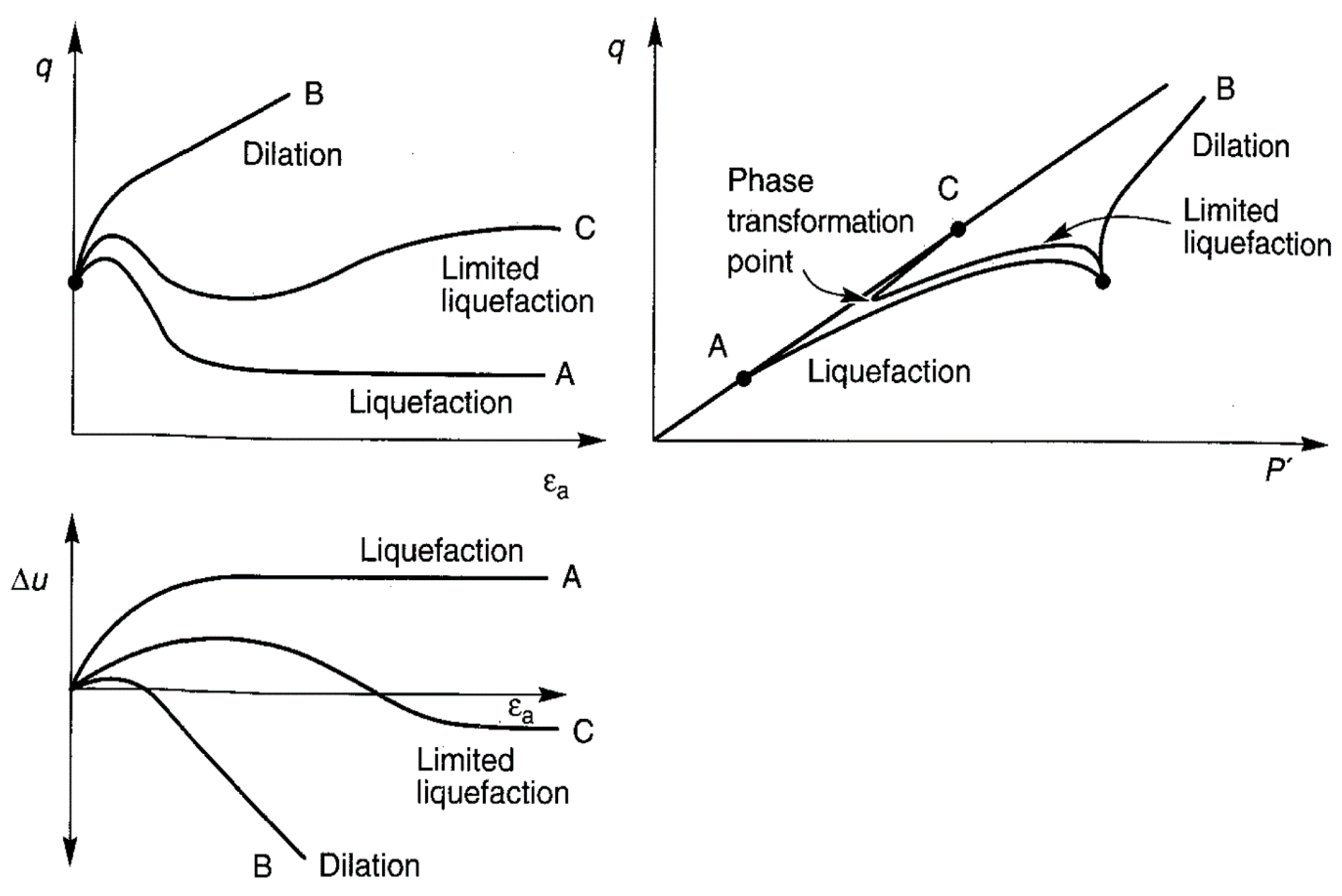
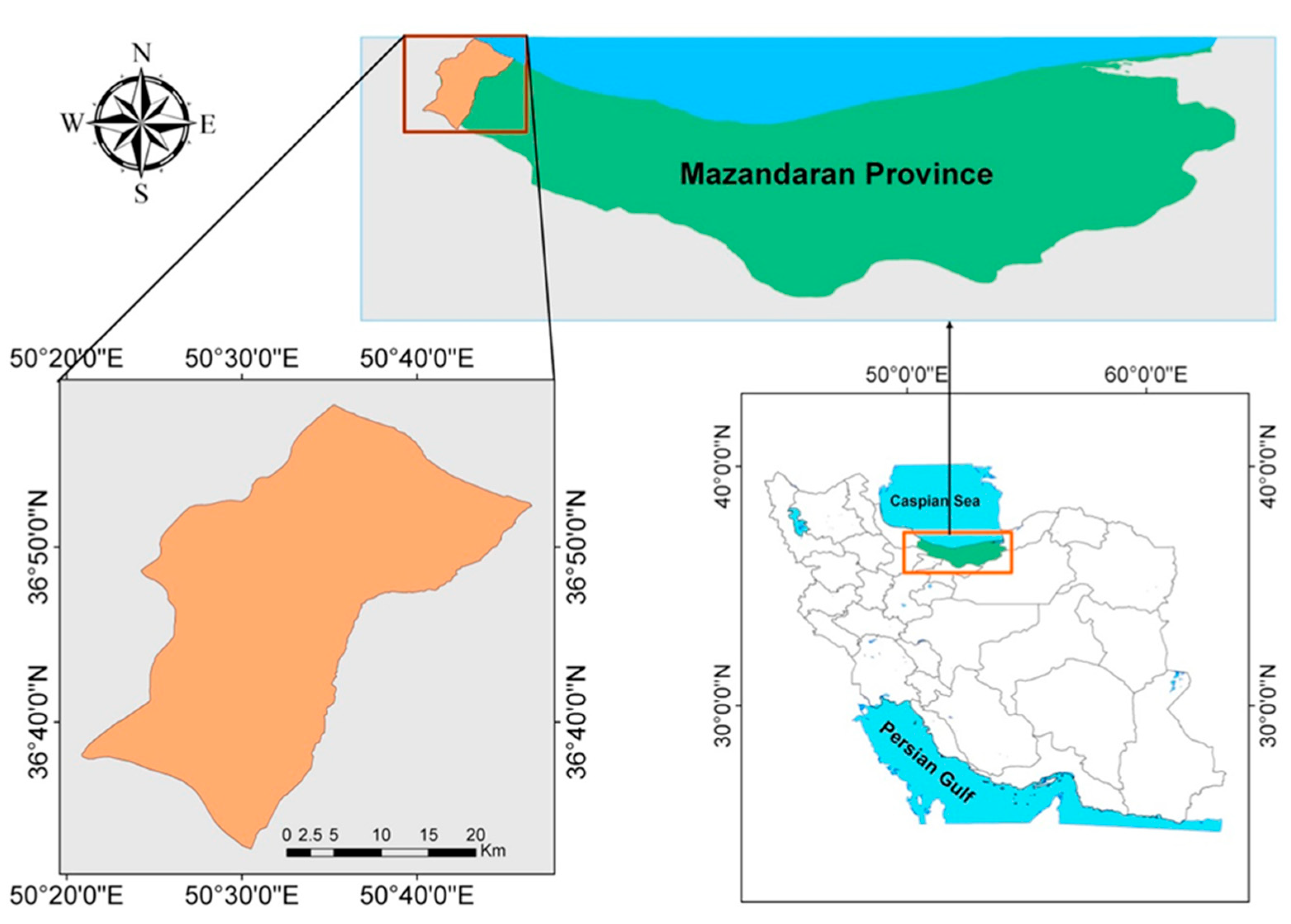



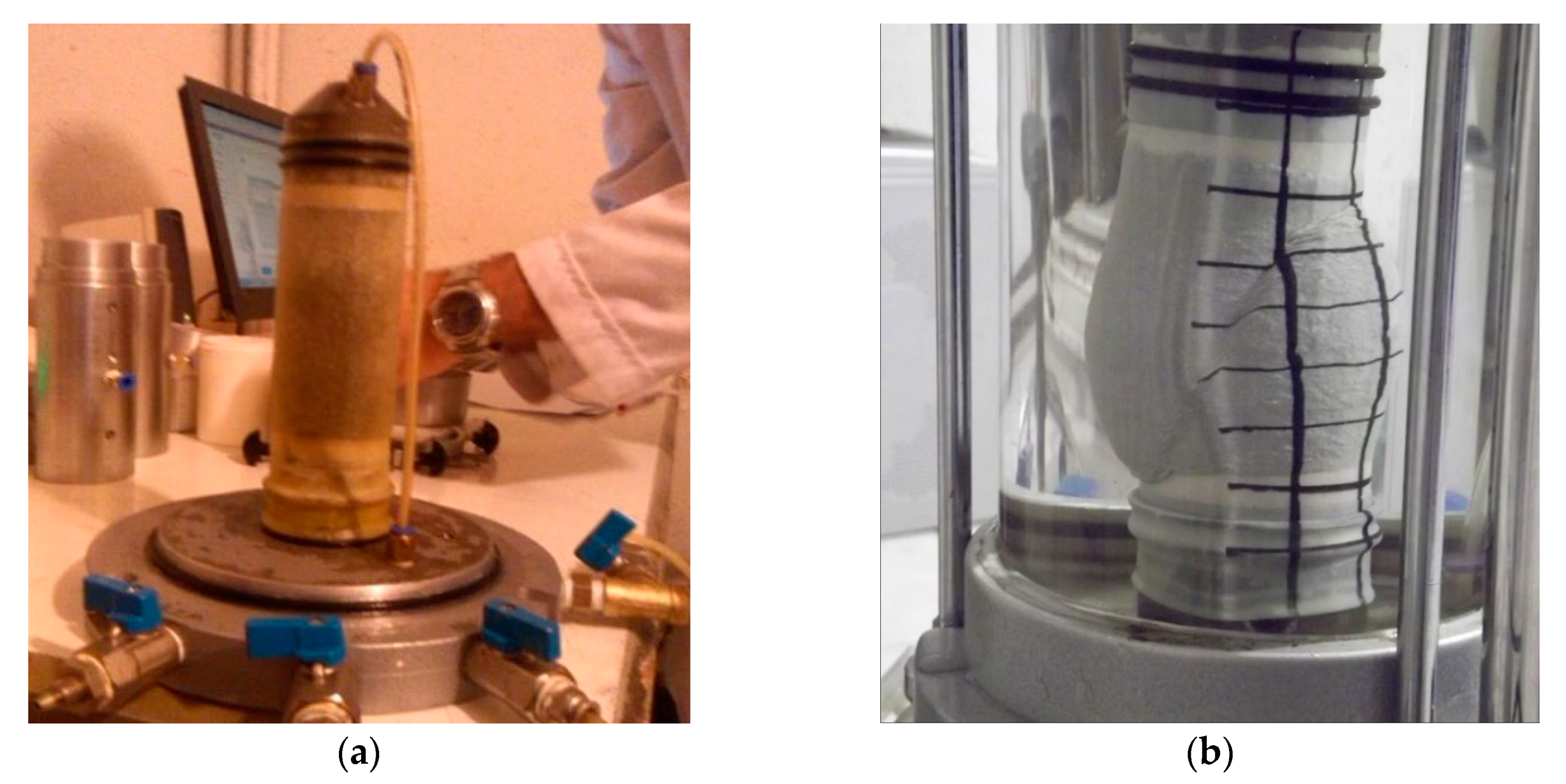

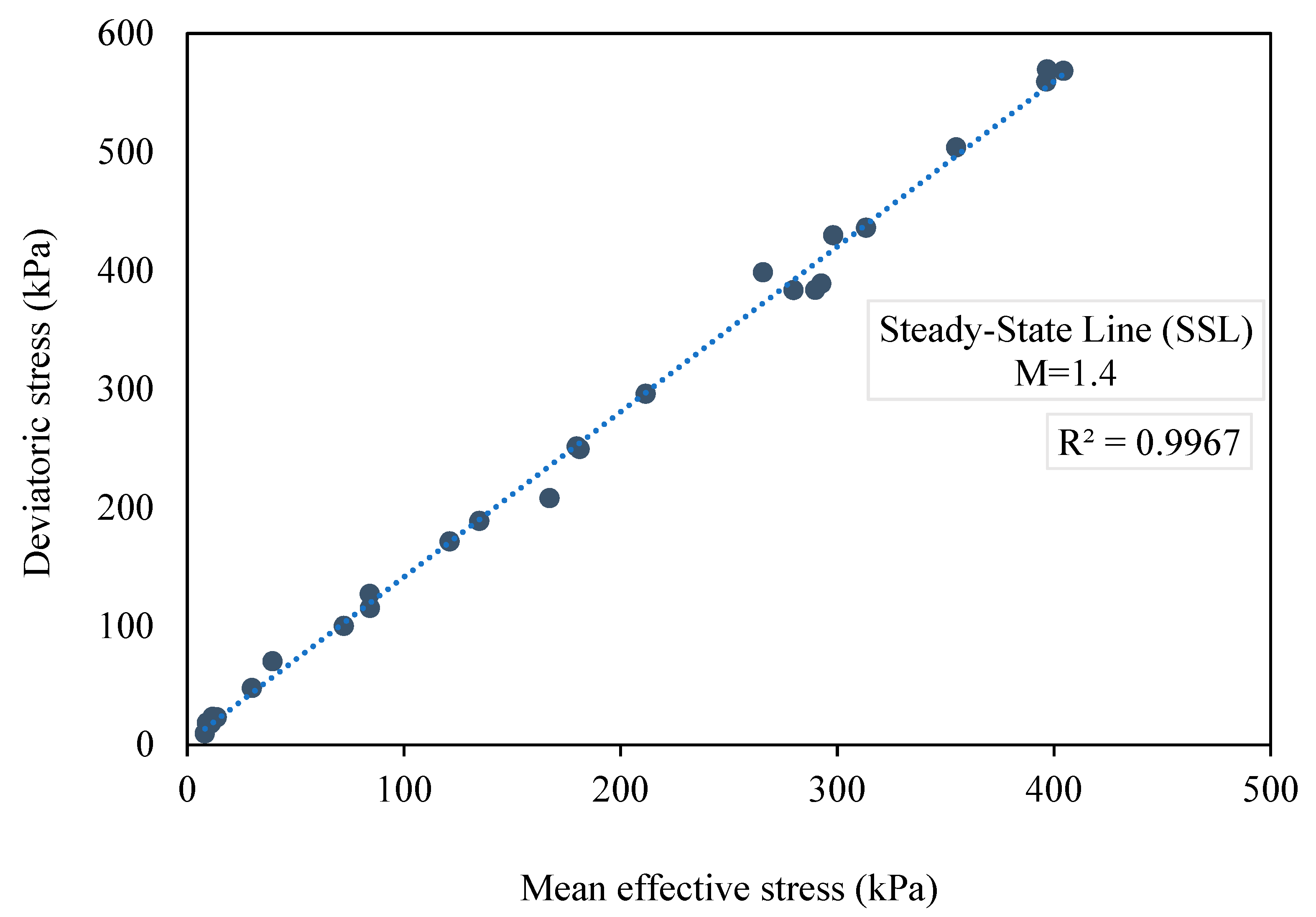
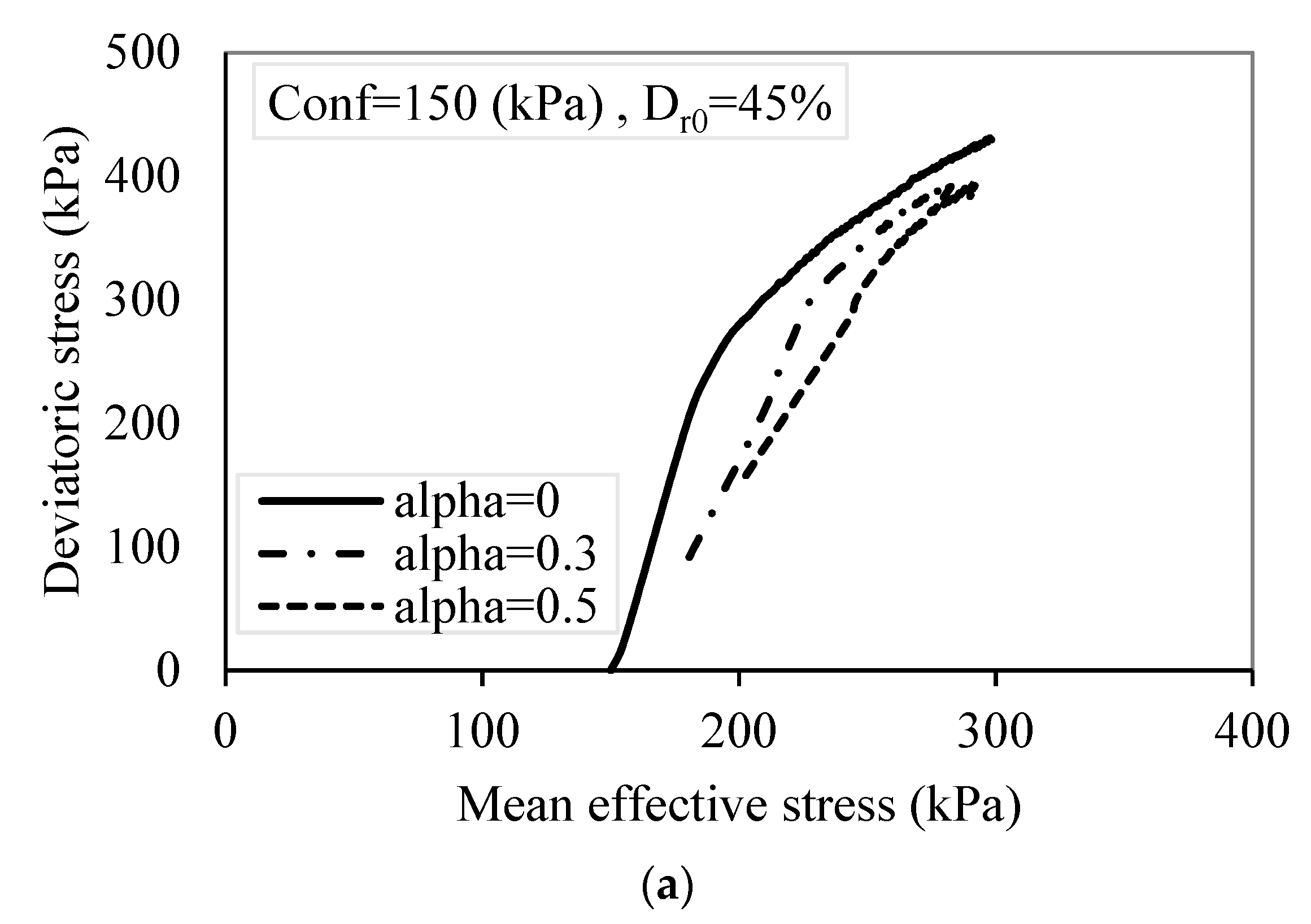
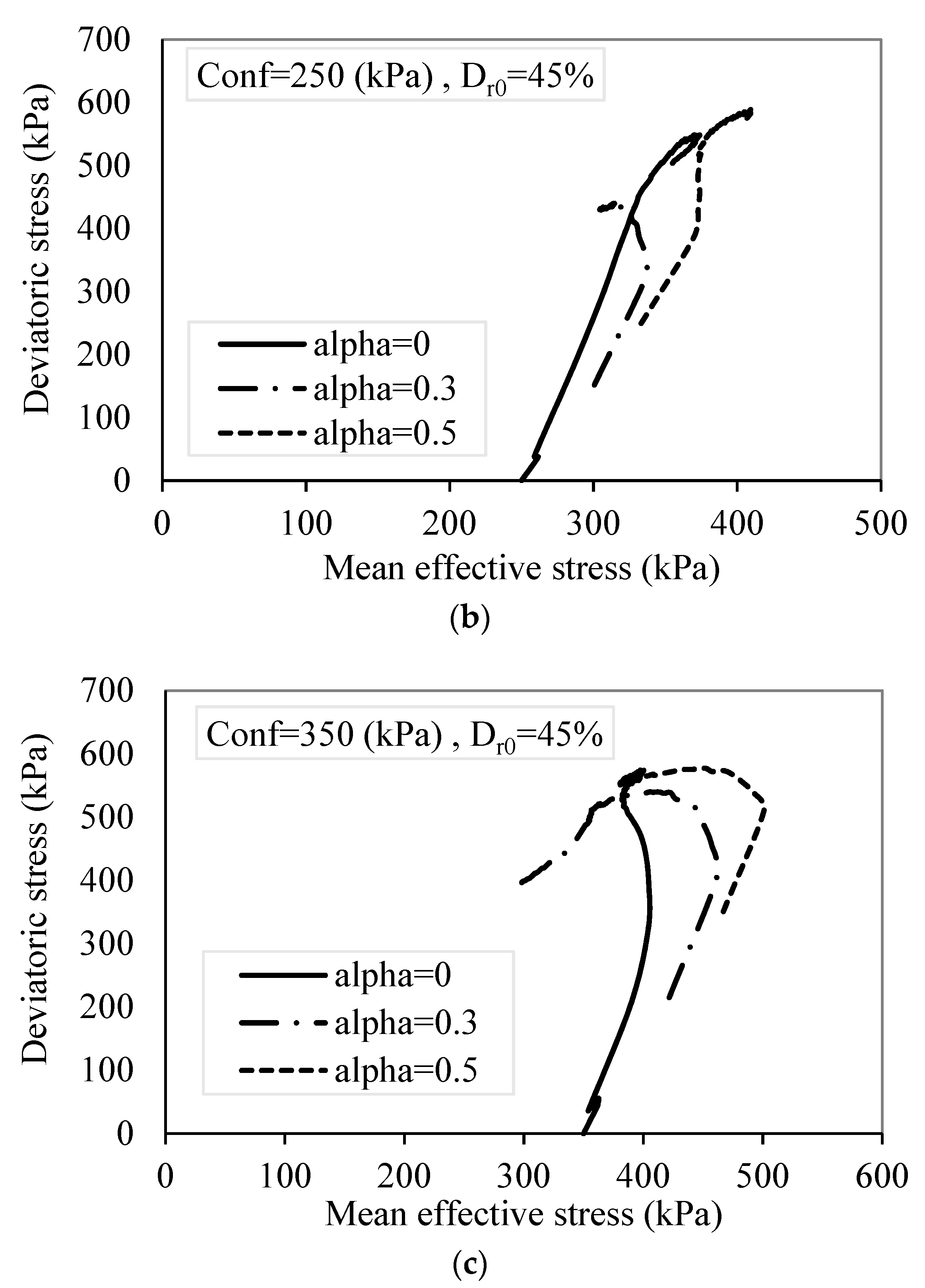
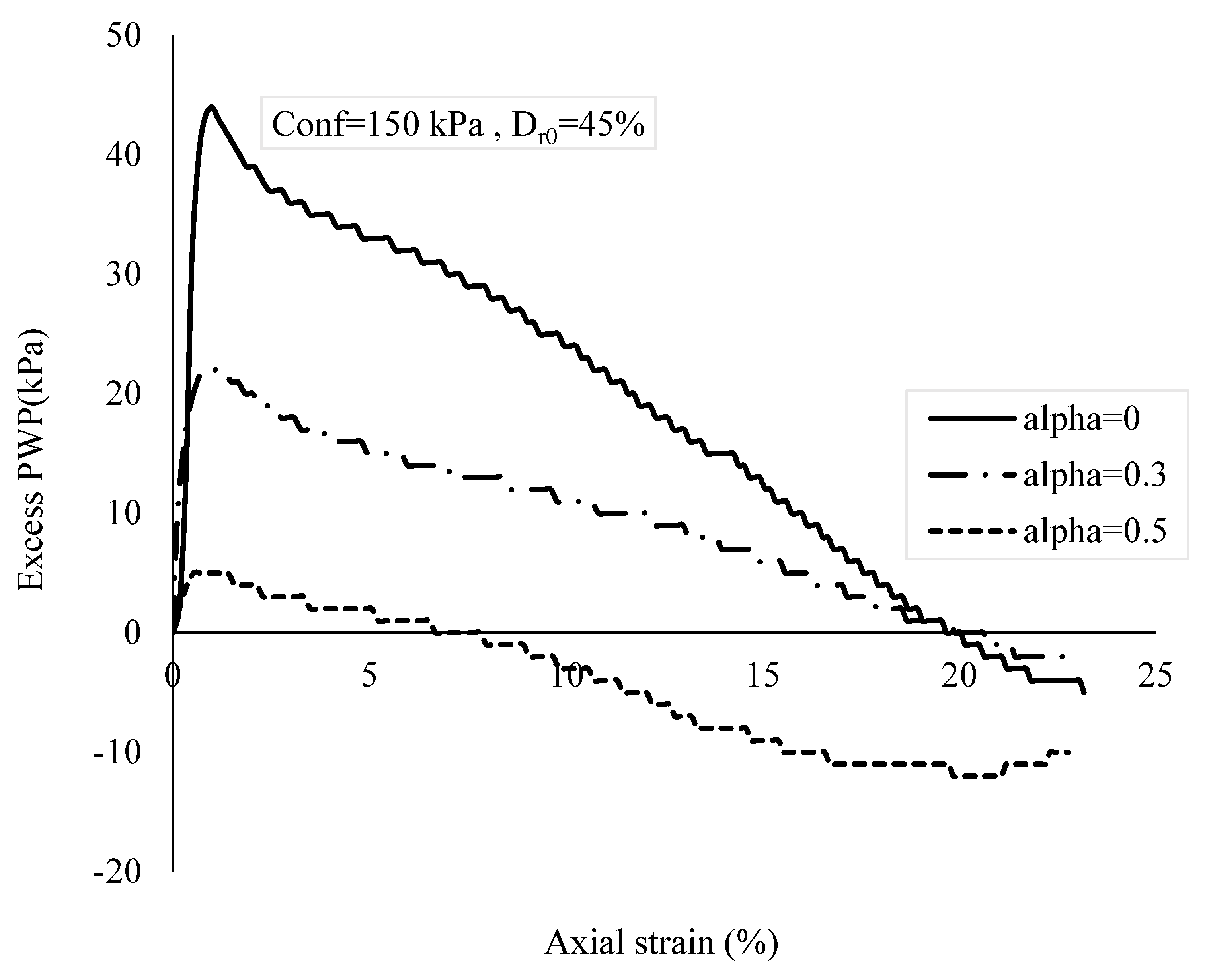
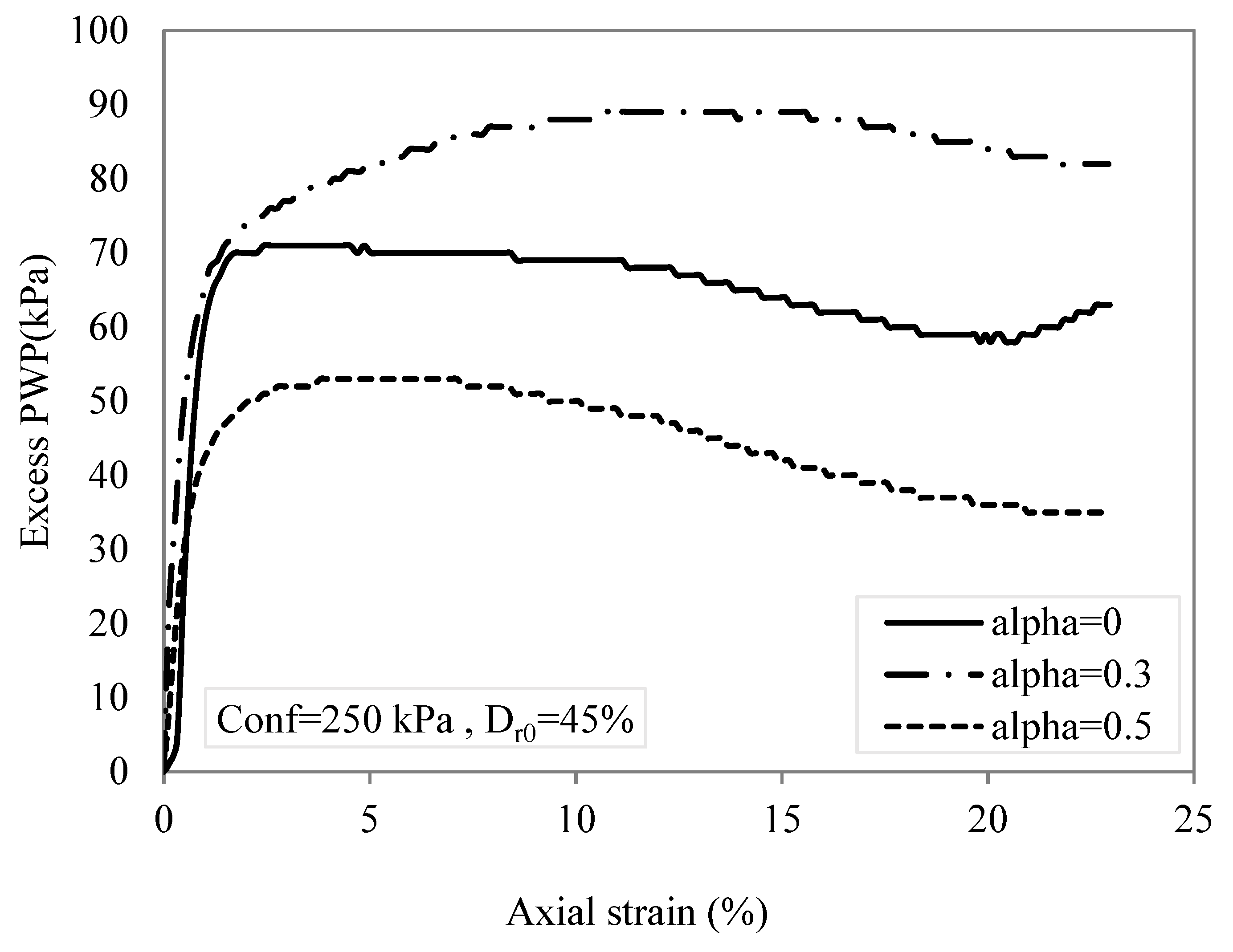
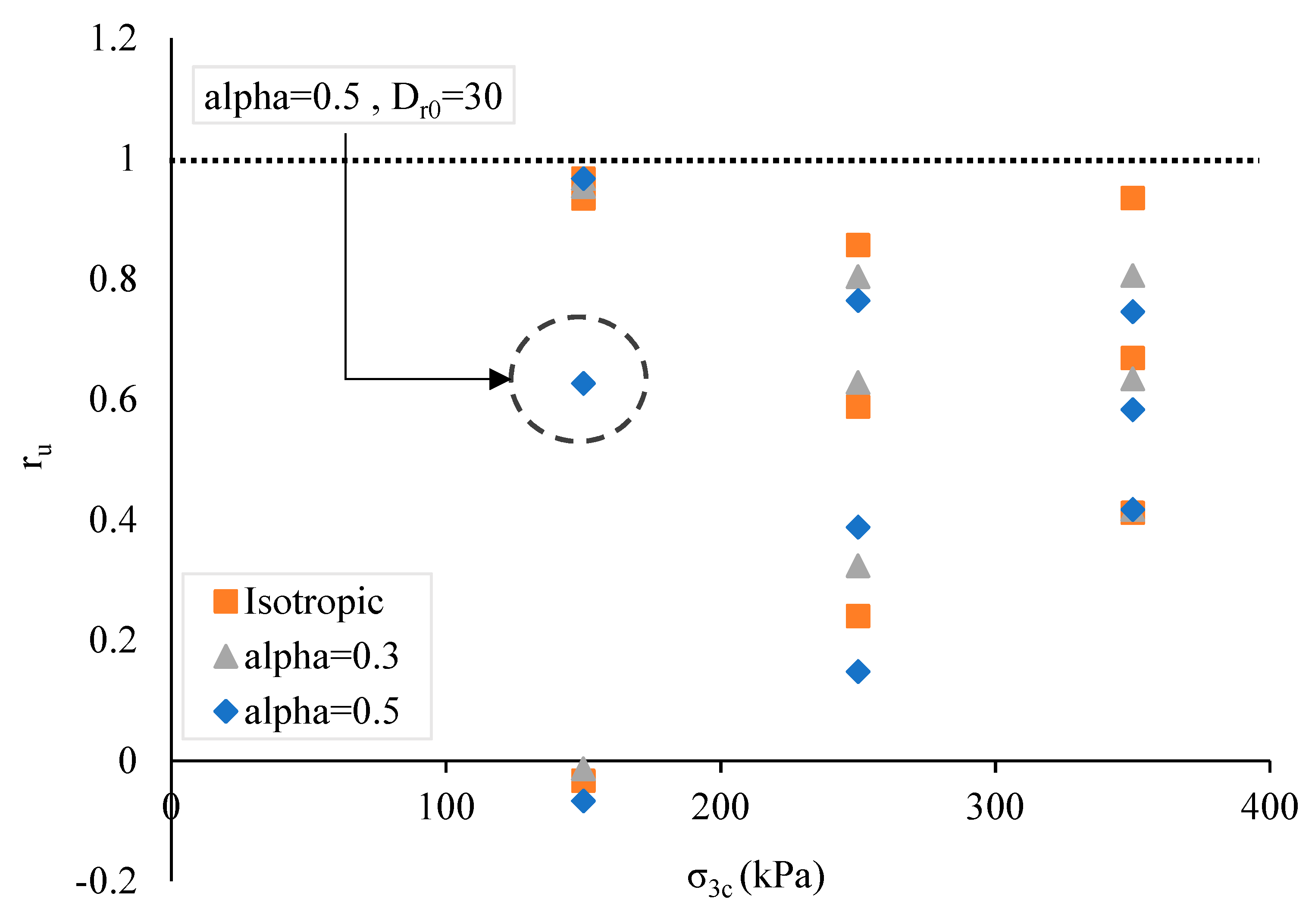
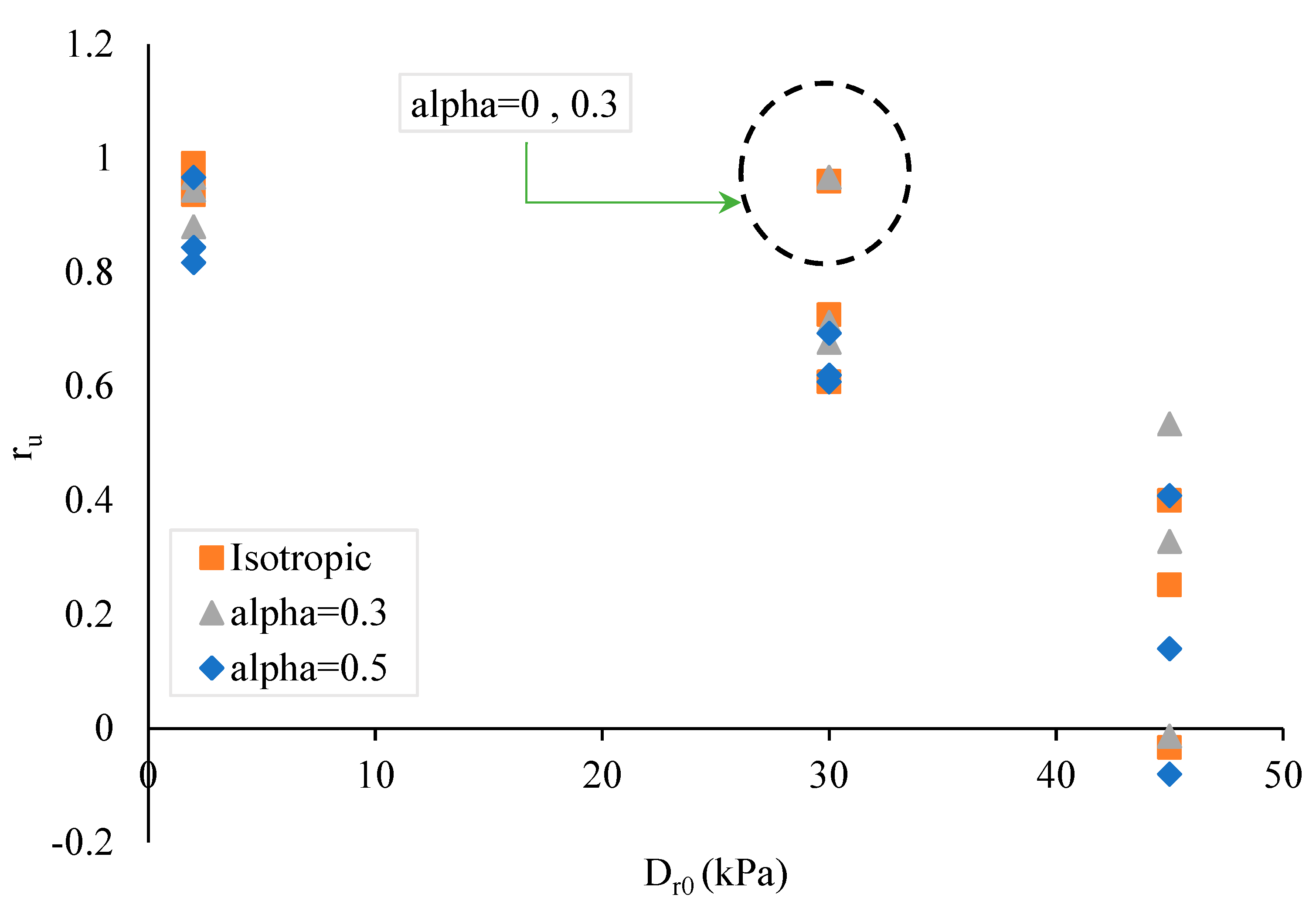
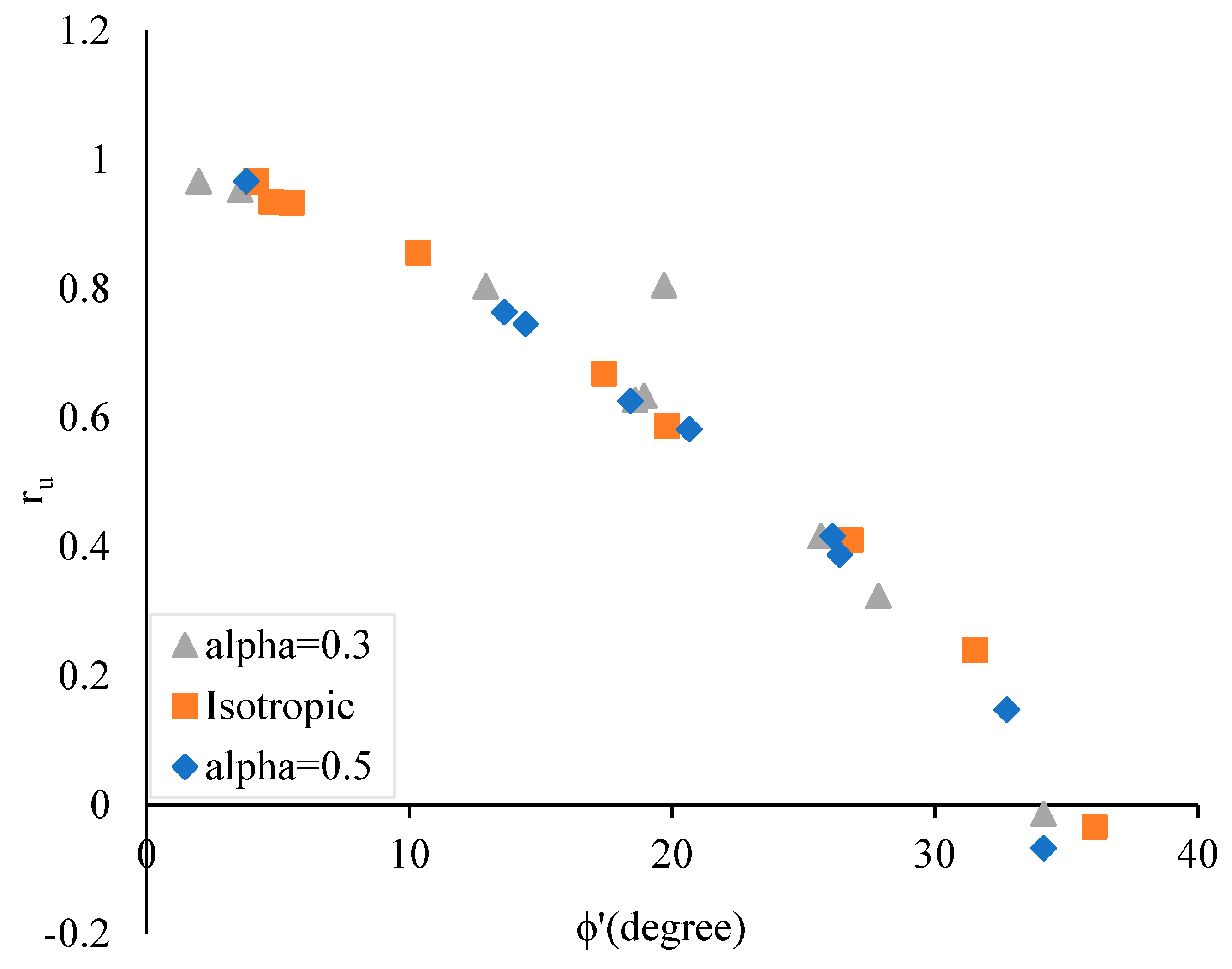

| Parameters | Values |
|---|---|
| Maximum void ratio, emax | 0.88 |
| Minimum void ratio, emin | 0.54 |
| Specific gravity, Gs | 2.67 |
| D50(mm) * | 0.22 |
| D10(mm) * | 0.147 |
| D30(mm) * | 0.187 |
| D60(mm) * | 0.246 |
| Coefficient of curvature, Cc | 0.96 |
| Coefficient of uniformity, Cu | 1.67 |
| # | Series | α | Situ | σ3c (kPa) | Dr0 (%) | Drc (%) | Result |
|---|---|---|---|---|---|---|---|
| 1 | (R–A)1 | 0 | ICU | 150 | 2 | 12.1 | Liquefaction |
| 2 | (R–A)2 | 0 | ICU | 150 | 30 | 37.5 | Liquefaction |
| 3 | (R–A)3 | 0 | ICU | 150 | 45 | 51.5 | Dilation |
| 4 | (R–A)4 | 0 | ICU | 250 | 2 | 16.6 | Liquefaction |
| 5 | (R–A)5 | 0 | ICU | 250 | 30 | 42.7 | Liquefaction |
| 6 | (R–A)6 | 0 | ICU | 250 | 45 | 53.77 | Dilation |
| 7 | (R–A)7 | 0 | ICU | 350 | 2 | 22.48 | Liquefaction |
| 8 | (R–A)8 | 0 | ICU | 350 | 30 | 37.37 | Liquefaction |
| 9 | (R–A)9 | 0 | ICU | 350 | 45 | 55.35 | Limited |
| 10 | (R–B)1 | 0.3 | ACU | 150 | 2 | 16.6 | Liquefaction |
| 11 | (R–B)2 | 0.3 | ACU | 150 | 30 | 38 | Liquefaction |
| 12 | (R–B)3 | 0.3 | ACU | 150 | 45 | 52.24 | Dilation |
| 13 | (R–B)4 | 0.3 | ACU | 250 | 2 | 20.6 | Liquefaction |
| 14 | (R–B)5 | 0.3 | ACU | 250 | 30 | 42.25 | Liquefaction |
| 15 | (R–B)6 | 0.3 | ACU | 250 | 45 | 54.3 | Liquefaction |
| 16 | (R–B)7 | 0.3 | ACU | 350 | 2 | 26.7 | Liquefaction |
| 17 | (R–B)8 | 0.3 | ACU | 350 | 30 | 44.91 | Liquefaction |
| 18 | (R–B)9 | 0.3 | ACU | 350 | 45 | 57.16 | Liquefaction |
| 19 | (R–C)1 | 0.5 | ACU | 150 | 2 | 18.55 | Liquefaction |
| 20 | (R–C)2 | 0.5 | ACU | 150 | 30 | 39.9 | Liquefaction |
| 21 | (R–C)3 | 0.5 | ACU | 150 | 45 | 53.02 | Dilation |
| 22 | (R–C)4 | 0.5 | ACU | 250 | 2 | 24.45 | Liquefaction |
| 23 | (R–C)5 | 0.5 | ACU | 250 | 30 | 43.7 | Liquefaction |
| 24 | (R–C)6 | 0.5 | ACU | 250 | 45 | 54.57 | Limited |
| 25 | (R–C)7 | 0.5 | ACU | 350 | 2 | 30.62 | Liquefaction |
| 26 | (R–C)8 | 0.5 | ACU | 350 | 30 | 41.94 | Liquefaction |
| 27 | (R–C)9 | 0.5 | ACU | 350 | 45 | 57.4 | Liquefaction |
Publisher’s Note: MDPI stays neutral with regard to jurisdictional claims in published maps and institutional affiliations. |
© 2020 by the authors. Licensee MDPI, Basel, Switzerland. This article is an open access article distributed under the terms and conditions of the Creative Commons Attribution (CC BY) license (http://creativecommons.org/licenses/by/4.0/).
Share and Cite
Nategh, M.; Ekinci, A.; Iravanian, A.; Salamatpoor, S. Determination of Initial-Shear-Stress Impact on Ramsar-Sand Liquefaction Susceptibility through Monotonic Triaxial Testing. Appl. Sci. 2020, 10, 7772. https://doi.org/10.3390/app10217772
Nategh M, Ekinci A, Iravanian A, Salamatpoor S. Determination of Initial-Shear-Stress Impact on Ramsar-Sand Liquefaction Susceptibility through Monotonic Triaxial Testing. Applied Sciences. 2020; 10(21):7772. https://doi.org/10.3390/app10217772
Chicago/Turabian StyleNategh, Mehrdad, Abdullah Ekinci, Anoosheh Iravanian, and Siavash Salamatpoor. 2020. "Determination of Initial-Shear-Stress Impact on Ramsar-Sand Liquefaction Susceptibility through Monotonic Triaxial Testing" Applied Sciences 10, no. 21: 7772. https://doi.org/10.3390/app10217772
APA StyleNategh, M., Ekinci, A., Iravanian, A., & Salamatpoor, S. (2020). Determination of Initial-Shear-Stress Impact on Ramsar-Sand Liquefaction Susceptibility through Monotonic Triaxial Testing. Applied Sciences, 10(21), 7772. https://doi.org/10.3390/app10217772





